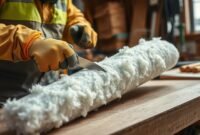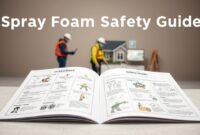One effective way to keep your house warm during winter and save money on energy bills is with proper attic insulation, such as fiberglass and cellulose insulation.
By choosing the right type of insulation for your home, you can keep your budget within range when your home is equipped with the recommended amount of insulation, ensuring energy efficiency and comfort.
Proper insulation, such as spray foam insulation, can help you save 10 to 50 percent of the electricity bill. So, how thick should attic insulation be to be considered appropriate? The amount of insulation, including cellulose insulation, varies depending on the climate and the type of insulation used. Here’s what you need to know.
How Thick Should Attic Insulation Be?
The climate is the first thing you must consider before deciding on the insulation thickness. Attic insulation, such as spray foam insulation, plays a big part in keeping the heat inside your house.
Therefore, you must install attic insulation that matches the climate and provides energy efficiency. This has something to do with the R-values of the insulation.

If you’re unfamiliar, The R-value is the number you want to look up to measure a barrier’s ability to resist heat flow. This value is crucial in determining the recommended level of inches of insulation needed in your attic, whether it’s loose fill or batt insulation, to serve its purpose effectively.
The life expectancy of different types of insulation, such as fiberglass and cellulose, can vary, with some lasting up to 30 years or more. The higher the R-value, the warmer you can keep your house.
If your house already has existing attic insulation, then inspect it thoroughly. This inspection will help you determine whether you need additional insulation, such as spray foam insulation, which can enhance energy efficiency. Over time, insulation can break down, leading to increased maintenance costs and reduced effectiveness.
For instance, you likely have enough if you cannot see the floor joists because they are covered by 14 inches or more of insulation. However, if they are visible, it’s recommended that attics have more added.
If they are easily seen, you might need to add more insulation. Also, make sure that it is appropriately distributed. The U.S. Department of Energy (DOE) and the International Energy Conservation Code (IECC) create a system to categorize each area into 7 levels.
This also affects the insulation thickness chart. For example, New York state is in Zone 4, Los Angeles is in Zone 3, and Alaska is in Zone 7.
Another thing you need to know is whether you want to include the attic in the insulation. Insulating the top ceiling of the attic creates a warm loft, which means that your attic is also a warm space. You could also insulate directly in the ceiling of the top story. Creating a cold loft.
Read also: Basement Ceiling Insulation Faced or Unfaced
Best Insulation for Attic Ceiling
There are many options for attic insulation. The common materials include fiberglass insulation, cellulose, and spray foam. Each type of insulation has its own pros and cons, and the amount of attic insulation needed can vary based on the material used.
Before you decide, you might want to know about each insulation’s pros and cons.
- Blow-in Fiberglass Attic Insulation
Fiberglass is very air-tight. It can even trap sounds. A very efficient insulation material. It is also allergen-free. You can use the blow-in process to determine how thick attic insulation should be when using fiberglass. It will help you cover areas that are hard to reach. The disadvantage of fiberglass is that it can easily trap water, too.
- Blow-in Cellulose Attic Insulation
If you want eco-friendly attic insulation types, you can use cellulose. It is made from recycled materials. It makes the materials inexpensive. Boric acid is also known as a pest-repellent material due to its composition. The blow-in process can help you reach smaller areas and make better coverage for the attic insulation. However, it is heavier than fiberglass and more likely to absorb water.
- Spray Foam Insulation
Firstly, spray foam is a good material for long-lasting insulation. They are firm and can show a high quality after settling. This can also support the structure of your home. The R-value of the spray foam is between 5.6 and 8.0, with no vapor barrier. On the other hand, professional spray foam insulation needs to be done, which means additional installation fees.
Read also: Is Spray Foam Insulation Waterproof?
That is all you need to know about attic insulation. Make sure that you have done a thorough inspection before continuing to apply the attic insulation. The inspection will help you determine how thick should attic insulation should be.


